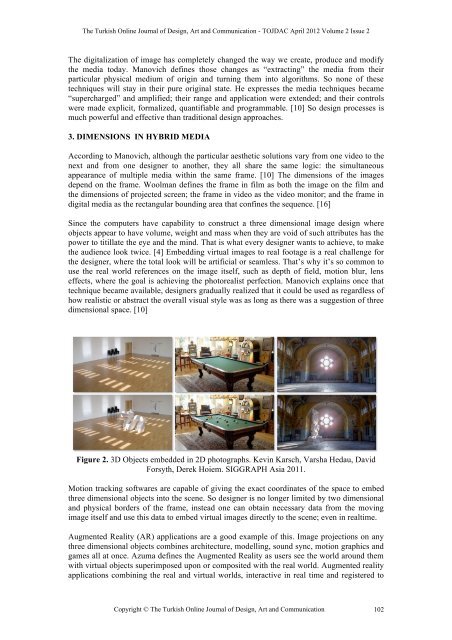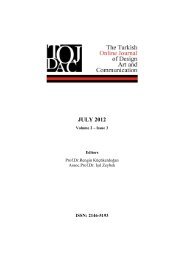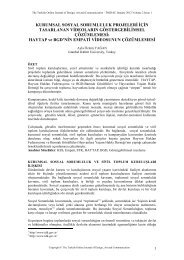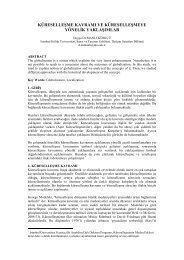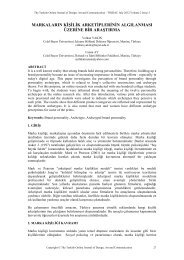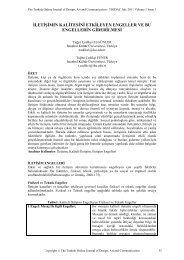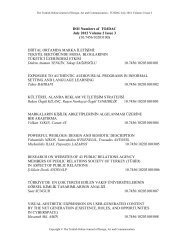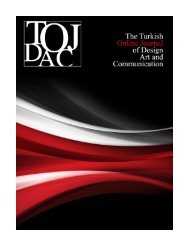aprıl 2012 - tojdac.org
aprıl 2012 - tojdac.org
aprıl 2012 - tojdac.org
You also want an ePaper? Increase the reach of your titles
YUMPU automatically turns print PDFs into web optimized ePapers that Google loves.
The Turkish Online Journal of Design, Art and Communication - TOJDAC April <strong>2012</strong> Volume 2 Issue 2<br />
The digitalization of image has completely changed the way we create, produce and modify<br />
the media today. Manovich defines those changes as “extracting” the media from their<br />
particular physical medium of origin and turning them into algorithms. So none of these<br />
techniques will stay in their pure original state. He expresses the media techniques became<br />
“supercharged” and amplified; their range and application were extended; and their controls<br />
were made explicit, formalized, quantifiable and programmable. [10] So design processes is<br />
much powerful and effective than traditional design approaches.<br />
3. DIMENSIONS IN HYBRID MEDIA<br />
According to Manovich, although the particular aesthetic solutions vary from one video to the<br />
next and from one designer to another, they all share the same logic: the simultaneous<br />
appearance of multiple media within the same frame. [10] The dimensions of the images<br />
depend on the frame. Woolman defines the frame in film as both the image on the film and<br />
the dimensions of projected screen; the frame in video as the video monitor; and the frame in<br />
digital media as the rectangular bounding area that confines the sequence. [16]<br />
Since the computers have capability to construct a three dimensional image design where<br />
objects appear to have volume, weight and mass when they are void of such attributes has the<br />
power to titillate the eye and the mind. That is what every designer wants to achieve, to make<br />
the audience look twice. [4] Embedding virtual images to real footage is a real challenge for<br />
the designer, where the total look will be artificial or seamless. That’s why it’s so common to<br />
use the real world references on the image itself, such as depth of field, motion blur, lens<br />
effects, where the goal is achieving the photorealist perfection. Manovich explains once that<br />
technique became available, designers gradually realized that it could be used as regardless of<br />
how realistic or abstract the overall visual style was as long as there was a suggestion of three<br />
dimensional space. [10]<br />
Figure 2. 3D Objects embedded in 2D photographs. Kevin Karsch, Varsha Hedau, David<br />
Forsyth, Derek Hoiem. SIGGRAPH Asia 2011.<br />
Motion tracking softwares are capable of giving the exact coordinates of the space to embed<br />
three dimensional objects into the scene. So designer is no longer limited by two dimensional<br />
and physical borders of the frame, instead one can obtain necessary data from the moving<br />
image itself and use this data to embed virtual images directly to the scene; even in realtime.<br />
Augmented Reality (AR) applications are a good example of this. Image projections on any<br />
three dimensional objects combines architecture, modelling, sound sync, motion graphics and<br />
games all at once. Azuma defines the Augmented Reality as users see the world around them<br />
with virtual objects superimposed upon or composited with the real world. Augmented reality<br />
applications combining the real and virtual worlds, interactive in real time and registered to<br />
Copyright © The Turkish Online Journal of Design, Art and Communication 102


